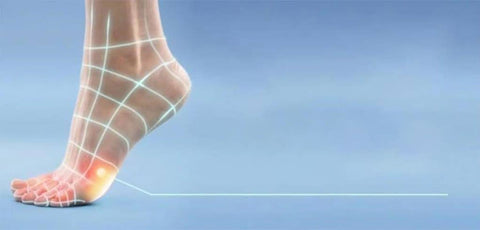Foot Corns — Causes, Signs, & Treatment
Causes, Signs, Solutions and Prevention
What Is A Corn?
Hard skin on your feet occurs when the outer layer of skin becomes thick and hardened — this is your skin’s way of protecting itself from friction (rubbing) and pressure, such as from your shoes.1,2 With continued friction and pressure, areas of thick, hard skin can develop into a corn.3 A corn is usually small, with a central core, and occurs on or between toes.1,2 A corn may appear white2 with a central core and obvious edges.1
Foot issues such as corns are more common in the elderly, but corns on feet can also affect people who spend a lot of time standing, whose feet that roll inwards or outwards (flat feet or high-arches), who wear poor-fitting shoes or who have other foot issues.2 Women tend to experience foot corns more often than men.4
What Causes Foot Corns?
When friction and pressure on your feet increase, more skin cells are produced to form a thick, hardened layer on the surface.1
Unfortunately, these areas of hard skin can in turn increase the pressure and friction from shoes, which can then worsen the hard skin.1,3 This may lead to the formation of foot corns, which are often painful due to how deeply the build-up of skin is pressing.1
What are the Signs of Foot Corns?
Foot corns are divided into two categories:1,3
- Hard corns are the most common type, featuring a dry horny mass with the characteristic semi-transparent central core. They typically appear on the outside of the fifth toe or on the outer joints of other toes.
- Soft corns are corns that have absorbed excessive amounts of moisture from sweating, forming a softened, mashed appearance. They typically form between toes, often the fourth and fifth toes and can be very painful.
How To Prevent and Remove Corns
The best way to treat hard skin is to remove the cause of friction and pressure1,2 — this involves both making changes to your footwear and removing the hard skin on your feet.5

Exfoliating the corn
Foot corn removal often involves paring away the corn itself.1,3 Further recurrence can then be managed by regularly trimming build-ups of outer skin, sometimes aided by soaking the affected area.1,3 Scholl’s 2-in-1 Corn Express Pen is a unique and convenient way to help manage corns.6

Padding
Therapeutic padding may also be used to reduce the amount of irritation to the site of the corn, helping to redistribute forces on the foot and allow the corn to heal.1,3 Scholl Corn Shield Gel Plasters utilise a revolutionary dual layer Hydra-Guard™ Technology. Use them to help cushion painful corns from friction and rubbing.7 Scholl Corn Removal Plasters are for use on hard corns. The medicated discs are placed on the corn itself, which helps focus treatment on the problem area.8

Managing Footwear
However, as long as the source of pressure or friction remains, the corn will continue to recur.2 For managing hard corns, footwear should be low-heeled, have a soft upper portion, and have a roomy toe area.1,3 Extra width is needed for corns on the outside of the fifth toe or for corns between toes.3 Corns can sometimes be caused by irregularities in the shoe itself, such a seam rubbing against the skin,1,3 so check your shoes to make sure this isn’t the case.
Optimising your general foot health
A simple maintenance routine is the best way of keeping your feet healthy and odour-free.9
- Daily care: Any pharmacist or podiatrist in Australia can advise on a daily care routine.
- Footwear: Ensure that your shoes fit properly (both in width and length) and are right for your activity.
- Appearance: Check the appearance of your feet regularly for any changes.
- Movement and flexibility: Check that you can move your feet easily, without discomfort; some simple stretches may help.
- Referral: Speak with your doctor or podiatrist if you have any concerns.9
